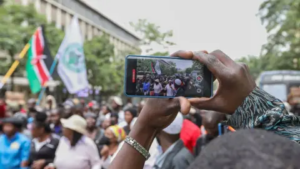Let’s take a break from the stressful politics and protests to focus on something closer to home — a river near your village. If you’re over 30, you might remember a time when that river was cleaner. Perhaps you fished there or fetched drinking water. Today, that river is much more polluted, no longer supporting aquatic life or providing potable water.
Back in 2021, Water Witness International revealed that global fast fashion brands were significantly polluting African rivers. This underscores how industries are harming our rivers, atmosphere, and natural resources, which affects biodiversity and sustainable livelihoods. This kind of pollution is not just an environmental issue but a social and economic one as well.
How can we in Kenya and across Africa tackle such severe environmental challenges to minimize their social and economic consequences?
Last week in Nairobi, I attended the International Union for Conservation of Nature’s (IUCN) first-ever Africa Conservation Forum. Over 700 environmentalists, industrialists, and government representatives from across Africa gathered to find answers. As a strong believer in pan-Africanism, I was thrilled to network and help develop major interventions for protecting our nature. I’ve grouped these solutions into four main areas.
Firstly, Africa’s environmental challenges cannot be solved by any single country. Unified, cross-sector action is crucial. African countries must collaborate, sharing resources, knowledge, and strategies. For example, nations sharing river basins must work together to ensure sustainable water management practices benefiting all communities along the river’s course.
Secondly, there is an urgent need to address the intertwined crises of climate change and biodiversity loss. Farmers in parts of the lower eastern region of Ukambani have never seen a mature maize cob due to erratic rainfall over decades. Climate change has stifled not just maize yield but biodiversity. It’s time to take decisive action, boosting agricultural productivity and biodiversity through sustainable farming practices.
Kenya’s Cabinet Secretary for Tourism and Wildlife, Dr. Mutua, emphasized the importance of transformational change, urging actions beyond rhetoric to deliver tangible results. This call for immediate, integrated actions reflects the urgency of the situation. We must now move from plan to action.
Thirdly, agriculture, a major driver of biodiversity loss, was a significant theme at the forum. Participants called for adopting agroecological practices and nature-based solutions that benefit both ecosystems and communities. In Kenya, we must adopt agroforestry, which combines trees with agriculture to improve soil health, increase crop yields, and provide farmers with additional income.
Finally, the forum highlighted that any successful conservation strategy must prioritize people, particularly Indigenous Peoples and local communities. For instance, wildlife conservation in Tsavo West National Park must address the need to boost sustainable livelihoods for the Taita community living adjacent to the park. As I always say, show an African person how to make money from trees, and they will grow those trees themselves, without waiting for you to provide seedlings. Empowering local communities through education, training, and financial support can foster a sense of ownership and responsibility towards conservation efforts.
In this regard, I sincerely urge the President to deploy the Green Economy to jump-start Kenya’s economy. UNEP defines a green economy as low carbon, resource-efficient, and socially inclusive. For example, tax incentives encouraging investors to set up regional electric car factories will create thousands of new jobs for our youth and lessen pollution. Such initiatives will also enhance the ability of local corporations to fund conservation projects, reducing reliance on foreign entities that sometimes impose ungodly conditions.
Africa needs to increase investment in its natural resources to strengthen its economies and societies. The forum showed that business models involving women and youth are highly beneficial. Effective conservation efforts require collaboration between governments, private sectors, and civil society, along with improved education and communication. Public education on conservation and how to contribute is crucial for long-term success.
God gave us nature. If we become faithful stewards of this nature, it will give us sustainable livelihoods. Think green, act green!



